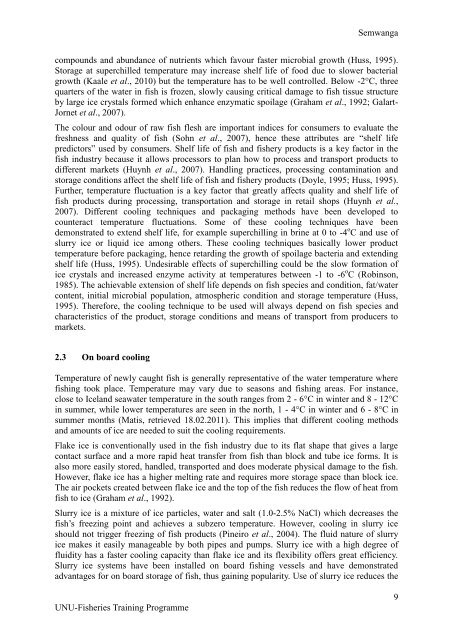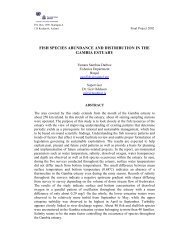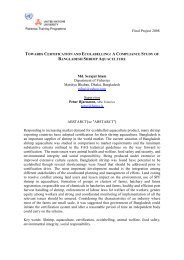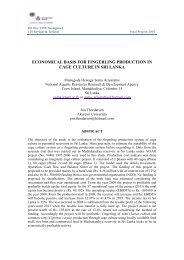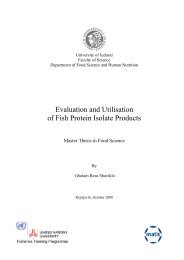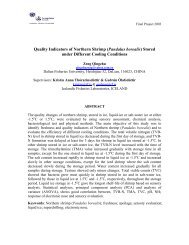THE EFFECT OF DIFFERENT COOLING TECHNIQUES ON THE ...
THE EFFECT OF DIFFERENT COOLING TECHNIQUES ON THE ...
THE EFFECT OF DIFFERENT COOLING TECHNIQUES ON THE ...
You also want an ePaper? Increase the reach of your titles
YUMPU automatically turns print PDFs into web optimized ePapers that Google loves.
Semwangacompounds and abundance of nutrients which favour faster microbial growth (Huss, 1995).Storage at superchilled temperature may increase shelf life of food due to slower bacterialgrowth (Kaale et al., 2010) but the temperature has to be well controlled. Below -2°C, threequarters of the water in fish is frozen, slowly causing critical damage to fish tissue structureby large ice crystals formed which enhance enzymatic spoilage (Graham et al., 1992; Galart-Jornet et al., 2007).The colour and odour of raw fish flesh are important indices for consumers to evaluate thefreshness and quality of fish (Sohn et al., 2007), hence these attributes are “shelf lifepredictors” used by consumers. Shelf life of fish and fishery products is a key factor in thefish industry because it allows processors to plan how to process and transport products todifferent markets (Huynh et al., 2007). Handling practices, processing contamination andstorage conditions affect the shelf life of fish and fishery products (Doyle, 1995; Huss, 1995).Further, temperature fluctuation is a key factor that greatly affects quality and shelf life offish products during processing, transportation and storage in retail shops (Huynh et al.,2007). Different cooling techniques and packaging methods have been developed tocounteract temperature fluctuations. Some of these cooling techniques have beendemonstrated to extend shelf life, for example superchilling in brine at 0 to -4 o C and use ofslurry ice or liquid ice among others. These cooling techniques basically lower producttemperature before packaging, hence retarding the growth of spoilage bacteria and extendingshelf life (Huss, 1995). Undesirable effects of superchilling could be the slow formation ofice crystals and increased enzyme activity at temperatures between -1 to -6 o C (Robinson,1985). The achievable extension of shelf life depends on fish species and condition, fat/watercontent, initial microbial population, atmospheric condition and storage temperature (Huss,1995). Therefore, the cooling technique to be used will always depend on fish species andcharacteristics of the product, storage conditions and means of transport from producers tomarkets.2.3 On board coolingTemperature of newly caught fish is generally representative of the water temperature wherefishing took place. Temperature may vary due to seasons and fishing areas. For instance,close to Iceland seawater temperature in the south ranges from 2 - 6°C in winter and 8 - 12°Cin summer, while lower temperatures are seen in the north, 1 - 4°C in winter and 6 - 8°C insummer months (Matis, retrieved 18.02.2011). This implies that different cooling methodsand amounts of ice are needed to suit the cooling requirements.Flake ice is conventionally used in the fish industry due to its flat shape that gives a largecontact surface and a more rapid heat transfer from fish than block and tube ice forms. It isalso more easily stored, handled, transported and does moderate physical damage to the fish.However, flake ice has a higher melting rate and requires more storage space than block ice.The air pockets created between flake ice and the top of the fish reduces the flow of heat fromfish to ice (Graham et al., 1992).Slurry ice is a mixture of ice particles, water and salt (1.0-2.5% NaCl) which decreases thefish’s freezing point and achieves a subzero temperature. However, cooling in slurry iceshould not trigger freezing of fish products (Pineiro et al., 2004). The fluid nature of slurryice makes it easily manageable by both pipes and pumps. Slurry ice with a high degree offluidity has a faster cooling capacity than flake ice and its flexibility offers great efficiency.Slurry ice systems have been installed on board fishing vessels and have demonstratedadvantages for on board storage of fish, thus gaining popularity. Use of slurry ice reduces theUNU-Fisheries Training Programme9


